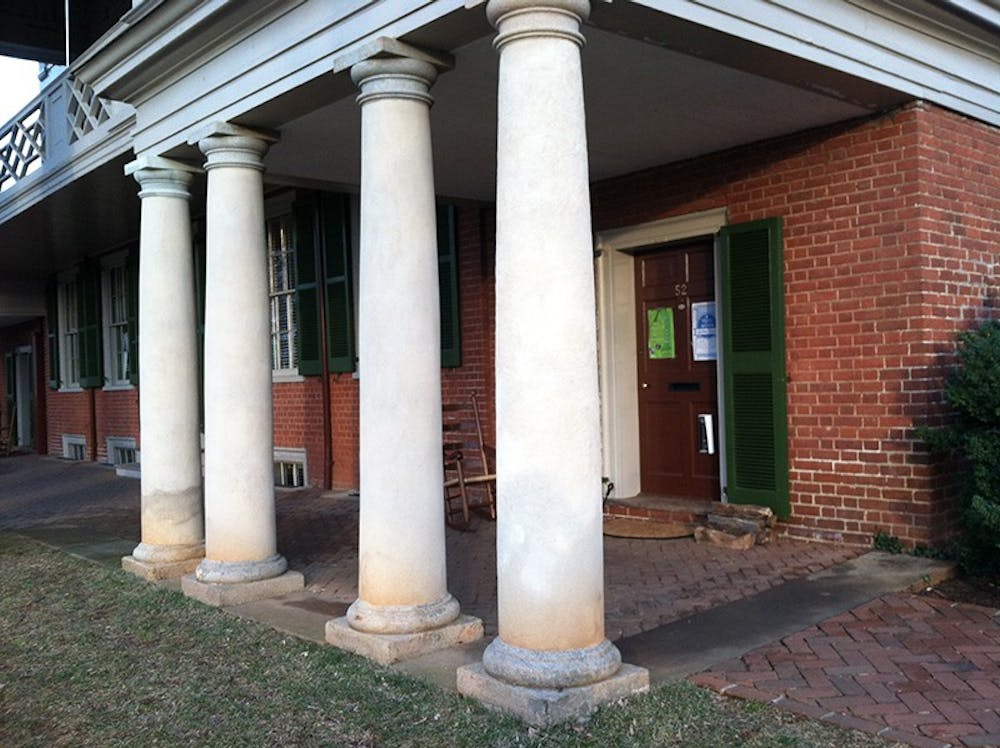The Lawn Selection Committee extended offers Friday to 47 students selected to live on the Lawn for the 2014-15 academic year. Selections for endowed and reserved rooms have not yet been decided.
Though male and female students each made up 50 percent of the 310-person applicant pool, 55 percent of those selected were female.
The application itself did not request race or ethnicity data, but the University provided figures by cross-referencing selectees with their Student Information System profiles. Just less than 80 percent of the selected students were white, while 21.3 percent were Asian, 6.4 percent African American and 4.3 percent Hispanic. SIS allows students to identify as more than one ethnicity.
Although the percentage of white students selected was higher than the white population at the University — only 71.7 percent of total undergraduates are white — Elijah Innes-Wimsatt, head Lawn resident and fourth-year Engineering student, said selection results often reflect the applicant pool rather than University or fourth-year class demographics.
Students from the College made up the highest percentage of selected applicants, coming in at 48.9 percent, followed by the Commerce School at 19.2 percent, the Engineering School at 14.9 percent, the Batten School at 8.5 percent, and the Nursing School at 4.3 percent. These numbers are also consistent with the applicant pool.
The mean GPA of applicants was 3.58, while the mean GPA for selected students was 3.78.
Every fall semester, the Lawn Selection Process Organizing Committee, which recruits members of the selection committee and is chaired by the Dean of Students, comes together to decide on the application format and timeline. The organizing committee includes the senior resident of the Lawn, student representatives from every school and representatives from key organizations like Student Council, the University Judiciary Committee and the Honor Committee.
The organizing committee also trains the selection committee on the criteria and process for selection. The selection committee is composed of 48 fourth-year students. Half of the committee members are randomly selected, and the other half come from the different academic schools and a broad cross-section of organizations — many of which overlap with members of the organizing committee — such as the Honor Committee, Student Council, the Asian Student Union, the Inter-Fraternity Council, the National Pan-Hellenic Council, the Queer Student Union and the Student Athlete Advisory Council.
Selection itself is a two-part process. First, each committee member individually reads every application and gives it a “yes” or “no,” with a limit of 65 “yes” responses. Applications are ordered based on the number of “yes” votes they receive, followed by a tie-breaking round in which committee members decide together on applicants who received the same number “yes” votes.
“The idea of the process is that … instead of coming together and deciding as a group … we have 48 individuals decide who they think should be on the Lawn,” Innes-Wimsatt said.
Applications are evaluated based on academic achievement, extracurricular involvement and continued commitment to the University community.
Innes-Wimsatt said the committee uses GPAs to make comparisons between students within the same school.
“There is a pretty big disparity between the average [GPA for] the College, the Comm-school and the Engineering School,” he said.
He also said diversity of University experience was a key factor in decisions.
“There is definitely not a formula for people that are here,” he said. “Coming in, I knew zero people who [were] on the Lawn. People here are from all over the University.”
The four endowed and four reserved Lawn rooms have their separate selection processes determined by the University Dean of Students or a separate selection committee.
Room 1 West, 7 West, 17 West and 37 West are traditionally assigned to a pre-health student, a Jefferson Literary and Debating Society member, a student nominated by the Trigon Engineering Society and the Honor Committee chair, respectively. Students selected for these rooms have to apply through the regular selection process, and the selection is approved or sometimes appointed by the University Dean of Students.
Room 15 West is the Gus Blagden Memorial Room, known as the “Good Guy” room, and requires nomination letters be sent to a separate committee describing the candidate’s service and impact at the University.
Room 46 East and Room 47 West Range are assigned to students nominated by the Kappa Sigma and Pi Kappa Alpha fraternities, respectively. Room 26 East is assigned to the individual selected to serve as Senior Resident of the Lawn.







